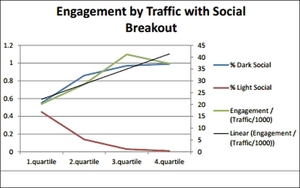
In what likely
is the first visible peek into the behavior of consumers using so-called
“dark social”media, some
first-of-its-kind data suggests that strikingly different patterns are emerging in terms of the way people consume -- and share -- media in “peer-to-peer” vs. public social media outlets.
The data, which comes from 33Across’ Tynt platform, is the first to track the content that consumers copy, paste and share across all digital media -- both public social media networks like
Facebook, Twitter and blogs, as well as interpersonal dark social media like email, SMS text, etc. What the data suggests is that while consumers typically share content from major publishers like
entertainment and general news sites publicly, they gravitate far more toward the long-tail of published content when they share things interpersonally.
advertisement
advertisement
“Overall, we’re finding that
larger sites have higher concentrations of Light Social while mid/longer-tail sites have higher concentrations of Dark Social,” explains John Haskins, CMO of 33Across, which has began analyzing
the differences at the request of MediaPost. Among other things, he says, “Dark Social is being associated with a peer-to-peer mindset, while Light Social is being associated with public-facing
persona curation.”
The finding is significant for several reasons, but especially for smaller and longer-tail publishers that are usually overlooked by mainstream agencies and brands
that tend to focus on the biggest publishers -- a trend that has become exacerbated as they focus more of their energy analyzing the value and impact of consumer behavior on big social media networks,
which in reality represent only a fraction of the way consumers share media content with each other.
According to Tynt's data, that could be contributing to a massive distortion of actual
consumer behavior. Based on its most recent findings, Dark Social currently represents about 71% of all social-sharing, while Light Social represents only 29%.
The skews become even more
exaggerated when 33Across began to dig into specific forms of content sharing, especially types of information consumers are prone to keep to themselves or a handful of close friends.
Take a
category like financial news and information, for example. According to the Tynt data, 90% of social traffic coming to business and financial publishers of all kinds -- both big and small -- is
generated from Dark Social vs. only 10% from Light Social.
“This is a category that thrives on peer-to-peer sharing,” explains Haskins, adding, “and not a persona curation
mindset.”
By contrast,Tynt's data shows that media and entertainment news and information publishers -- sites that cover high profile content like TV, movies, etc. -- currently generate
about two-thirds (67%) of their social traffic from Light Social networks.
Haskins says 33Across hopes to develop a standard index for tracking and analyzing these relationships, but in the
near term he says the data indicates how important it is for advertisers to begin looking beneath the surface of the most visible social media trends and behaviors to understand how consumers are
actually interacting with content.
“From a business perspective it's important for advertisers to not only understand this dynamic when they are creating their advertising, but also to
develop approaches for messaging to consumers at these key moments of sharing,” he says.